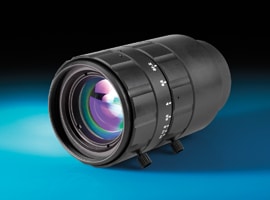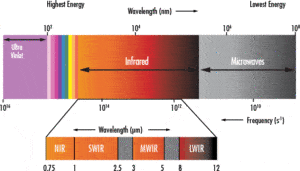Short-wave infrared (SWIR) light is typically defined as light in the 0.9 – 1.7μm wavelength range, but can also be classified from 0.7 – 2.5μm. Since silicon sensors have an upper limit of approximately 1.0μm, SWIR imaging requires unique optical and electronic components capable of performing in the specific SWIR range. Indium gallium arsenide (inGaAs) sensors are the primary sensors used in SWIR imaging, covering the typical SWIR range, but can extend as low as 550nm to as high as 2.5μm. Although linear line-scan inGaAs sensors are commercially available, area-scan inGaAs sensors are typically ITAR restricted. ITAR, International Treaty and Arms Regulations, is enforced by the government of the United States of America. ITAR restricted products must adhere to strict export and import regulations for them to be manufactured and/or sold within and outside of the USA. Nevertheless, lenses such as SWIR ones can be used for a number of commercial applications with proper licenses.
WHY USE SWIR?
 Unlike Mid-Wave Infrared (MWIR) and Long-Wave Infrared (LWIR) light, which is emitted from the object itself, SWIR is similar to visible light in that photons are reflected or absorbed by an object, providing the strong contrast needed for high resolution imaging. Ambient star light and background radiance (nightglow) are natural emitters of SWIR and provide excellent illumination for outdoor, nighttime imaging.
Unlike Mid-Wave Infrared (MWIR) and Long-Wave Infrared (LWIR) light, which is emitted from the object itself, SWIR is similar to visible light in that photons are reflected or absorbed by an object, providing the strong contrast needed for high resolution imaging. Ambient star light and background radiance (nightglow) are natural emitters of SWIR and provide excellent illumination for outdoor, nighttime imaging.
It is essential to use a lens that is designed, optimized, and coated for the SWIR wavelength range. Using a lens designed for the visible spectrum will result in lower resolution images and higher optical aberrations. Since SWIR wavelengths transmit through glass, lenses, and other optical components (optical filters, windows, etc.) designed for SWIR can be manufactured using the same techniques used for visible components, decreasing manufacturing cost and enabling the use of protective windows and filters within a system.
A large number of applications that are difficult or impossible to perform using visible light are possible using SWIR. When imaging in SWIR, water vapor, fog, and certain materials such as silicon are transparent. Additionally, colors that appear almost identical in the visible may be easily differentiated using SWIR.
SWIR APPLICATIONS
SWIR imaging is used in a variety of applications including electronic board inspection, solar cell inspection, produce inspection, identifying and sorting, surveillance, anti-counterfeiting, process quality control, and much more. To understand the benefits of SWIR imaging, consider some visual examples of common, everyday products imaged with visible light and with SWIR.
Short-wave infrared (SWIR) defines a specific wavelength range over which optical and electronic components are designed and coated. SWIR imaging offers a number of advantages compared to visible when used for inspection, sorting, surveillance, quality control, and host of other applications. It is important to choose components specifically designed, optimized, and coated for the SWIR wavelength range to ensure the highest resolution and lowest aberrations. Manufacturers like Edmund Optics are experienced in designing, manufacturing, and coating SWIR Series lenses. Edmund Optics offers lens assemblies designed with glasses that are optimized for performance in the SWIR spectrum, and anti-reflection (AR) coatings for SWIR specially designed for maximum transmission of SWIR wavelengths. View the SWIR Imaging Applications page to learn more about what Edmund Optics can do for you and answer the question “Can You See Beyond the Visible?”
A SWIR lens, or short wave infrared lens, is optimized for light in the 0.9 – 1.7μm
wavelength range. At Shanghai Optics we manufacture high quality SWIR lenses for surveillance, quality control, inspection and anti-counterfeiting imaging. Since ambient star light and background nightglow are natural providers of SWIR light, short wave infrared imagery is especially suited to night vision applications.
Our lenses feature the latest advancements in SWIR technology, and operate with less than 2 percent distortion. They have been designed to match InGaAs FPA formats, and are used in applications including solar cell testing, outdoor night vision imaging (for security applications), fruit surface scratches detection, silicone imaging, biomedical imaging, etc.
If a lens optimized for visible light is used in the SWIR range you will encounter high optical aberrations and the resulting images will have lower resolution. You can, however, use our SWIR short wave infrared lenses with visible light without degradation. We produce custom SWIR lenses for imaging applications that requires good quality images in visible, near infrared, and shortwave infrared spectral range. These lenses are specifically designed for installation into camera systems where they can generate high contrast images in various weather conditions including fog, dust, dawn, or night.
Understanding SWIR Vision
Colors that seem identical in the visible range can be differentiated easily using SWIR imaging. To the naked eye—or to a visible light camera—an apple may appear to be entirely red and perfect. SWIR imagery will produce an image that shows, in high contrast, any flaws, bruises, or soft spots.
The ability to see invisible colors isn’t the only benefit of SWIR imaging. Materials that would otherwise obscure images (water, vapor, fog, and silicon, for instance) are transparent to SWIR. This leads to applications in quality control (SWIR imagery can see through some packaging to the item within) as well as to outdoor surveillance (pictures taken in fog are just as clear as pictures taken on a bright sunny day). SWIR lenses are ideal for machine vision when you need to see what you simply can’t see with the naked eye.
Optical Characteristics of Shanghai Optics SWIR Lenses
High transmission, high spatial resolution and very low distortion are a hallmark of our SWIR lenses. They operate with very low levels of scattered and stray light, and perform with full-spectrum aberration correction. A high-precision focus locking mechanism will enable you to produce high resolution, fully focused images. Our in-stock options include an ultra-broadband antireflection coating, and other coatings are available upon request.
Key Features
Full-Spectrum Aberration Correction
High Transmission
High Spatial Resolution and Low Distortion
Low Levels of Scattered or Stray Light
High Precision Focus Locking Mechanism
In Stock Options
12.5 mm, 17 mm and 25 mm lenses are available off the shelf. These C-mount fixed focal length lenses are optimized for outstanding spectral resolution and high performance; for instance, the TV distortion of our 12.5 mm lens is no more than 1.58 percent. The minimum focus distance for our 25 mm and 12.5 mm lens is 0.3 m.
Click through to find detailed spec sheets, and contact us for current prices and product availability.
SWIR 12.5mm
SWIR 17mm
SWIR 25mm
SWIR Lens Design Assistance from Shanghai Optics
But you are not limited to our in-stock options. We have been producing high quality optics for 55 years, and there is little we don’t know. We’d love to put this extensive experience to work for you. Don’t have a complete design? Need a high resolution SWIR lens? No problem! Our pre-engineered lenses allow our customers the option to choose from a variety of preliminary designs based on what suits their application best. Just tell us your application requirements (dimensions, wavelength range, etc.) and our team of expert engineers will optimize our preliminary designs to meet your exact needs. This will save you the hassle of fully designing a product from scratch and help reduce or eliminate design fees!
Hyperspectral Imaging Lens 1.0μm-2.5μm SWIR Case Study
To learn more, please feel free to contact us at info@superiorcctv.com.
